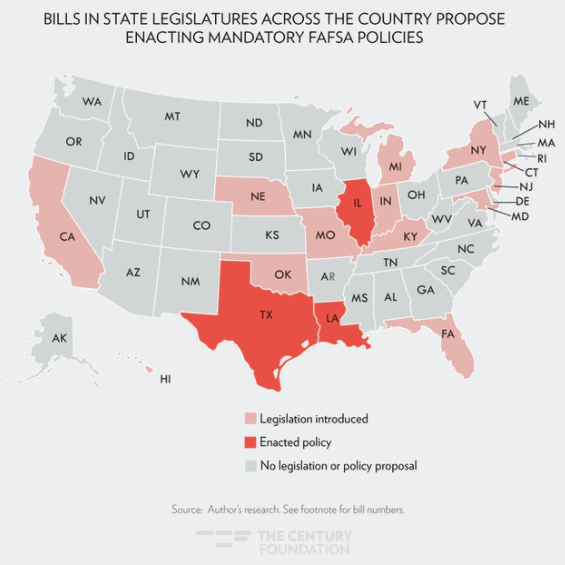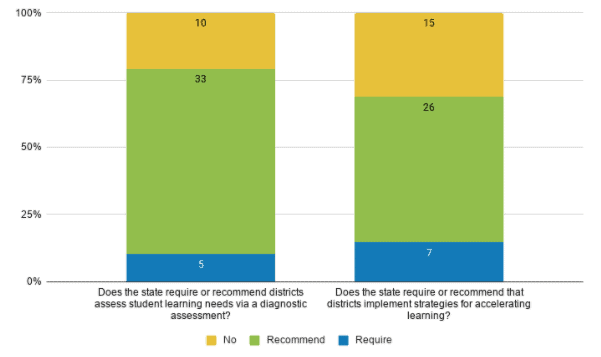Need to know: COVID-19
- As of noon on Friday, July 31, there were 122,148 confirmed cases. See cases by county here.
- The share of positive tests as a percentage of total tests is 8%.
- As of July 31, 1,229 people were hospitalized with ~23% of ICU beds available.
- From March 15 to July 30, 1,207,660 North Carolinians have filed unemployment insurance claims. The state has paid 834,823 claimants.
The other 49
A new report from the Century Foundation finds that mandatory FAFSA policies can greatly increase a state’s FAFSA completion rate when well-implemented. In Louisiana, the only state to have fully implemented a mandatory FAFSA policy, the share of public high schools that had a FAFSA completion rate of at least 65% increased from 1 in 3 before the policy to 4 in 5 now, according to the report.
Mandatory FAFSA policies, like Louisiana’s, require 12th graders to complete a FAFSA or submit an opt-out form in order to graduate. While only Louisiana has a fully implemented policy, the report says 13 states are currently considering one.

Importantly, the FAFSA completion gap between high-income and low-income districts decreased from 8.5 percentage points to 1.1 percentage points in one year.
As of July 17, 58.2% of North Carolina’s seniors had completed a FAFSA, earning North Carolina the rank of 20th in FAFSA completion rates. You can find FAFSA rates broken down by district in this map by EdNC’s Analisa Sorrells.
The report outlines the supports needed to make mandatory FAFSA policies successful. As part of EdNC’s FAFSA series in June, I interviewed Sujuan Boutté, the executive director of the Louisiana Office of Student Financial Assistance, who stressed the importance of support for schools, students, and families. Read more about Louisiana’s experience here.
For your consideration
Louisiana got a shout-out in another recent report from the Center on Reinventing Public Education (CRPE) and Public Impact. CRPE and Public Impact analyzed states’ guidance on school reopening plans and find that most focus on health and safety measures with few stating explicit expectations for districts when it comes to student learning.
For example, according to their analysis, only five states require districts to do a diagnostic assessment to understand student learning needs at the beginning of the school year (Louisiana being one of them), and only seven require or recommend districts implement strategies to address learning loss.

Read the rest of the report, including examples of how some states have addressed the digital divide, here.
Dropping knowledge
Preventing the next zoonotic (transferred from animals to humans) pandemic could cost between $22 to $31 billion per year, according to a new report from a coalition of scientists, including one from Duke University. While this may seem like a big number, the authors point out that we’ve already spent well beyond that responding to COVID-19 and those costs only continue to rise, not to mention lives lost to the pandemic. They write:
“Our analysis suggests that the associated costs of these preventive efforts would be substantially less than the economic and mortality costs of responding to these pathogens once they have emerged.”
The preventative efforts recommended have to do with how we interact with nature to reduce animal to human transmission, including reducing deforestation and ending the wild meat trade in China. The graphic below outlines their recommendations, their estimated costs, and the estimated costs from COVID-19.

What we're reading
We Need to Talk About Ventilation
This is one of the best explanations I've seen so far of what we know about airborne transmission of COVID-19 and so-called super-spreaders. ... Read the rest-
Searing Heat Will Make COVID-19 Racial Disparities Worse
-
More Than 6,600 Coronavirus Cases Have Been Linked to U.S. Colleges
-
Facing potentially steep declines in enrollment and increased costs to safely reopen schools, school superintendents call for the General Assembly to hold school budgets harmless
-
College Food Pantries Are Reinventing Ways to Feed Students
-
Glimpsing the end of the pier? Future hazy for NC coastal icons
-
Study Highlights Mental Health Risks Facing Healthcare Workers During Pandemic


